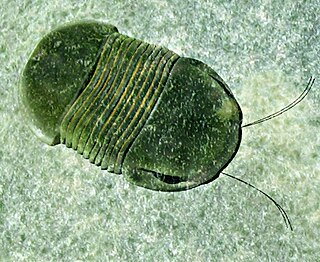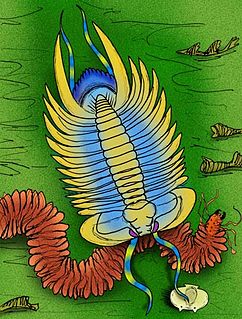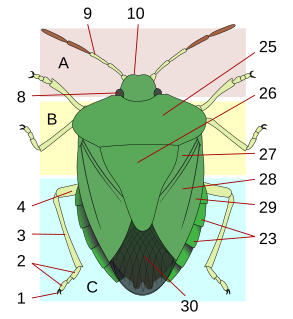
Trilobites are a group of extinct marine arachnomorph arthropods that form the class Trilobita. Trilobites form one of the earliest-known groups of arthropods. The first appearance of trilobites in the fossil record defines the base of the Atdabanian stage of the Early Cambrian period, and they flourished throughout the lower Paleozoic era before beginning a drawn-out decline to extinction when, during the Devonian, all trilobite orders except the Proetids died out. Trilobites disappeared in the mass extinction at the end of the Permian about 252 million years ago. The trilobites were among the most successful of all early animals, existing in oceans for over 300 million years.
Capricornia is a term sometimes used for northern Australia, derived from the Tropic of Capricorn. It can apply to any of the items below:

The pygidium is the posterior body part or shield of crustaceans and some other arthropods, such as insects and the extinct trilobites. It contains the anus and, in females, the ovipositor. It is composed of fused body segments, sometimes with a tail, and separated from thoracic segments by an articulation.
Auricle is an Anglicization of Latin auricula, from auris "ear" and -cula, a diminutive suffix.

Asaphus kowalewskii is one of the 35 species of trilobites of the genus Asaphus. Fossils of this species are popular among collectors because of their prominent stalked eyes, many an inch or more in length.
A fenestra is any small opening or pore, commonly used as a term in the biological sciences. It is Latin for the word "window", and is used in various fields to describe a pore in an anatomical structure.

Arachnomorpha is a subdivision or clade of Arthropoda, comprising the monophyletic group formed by the trilobites, other great appendage arthropods and trilobite-like families, and a diverse sister clade including the chelicerates. Great debate is held on the position of the Pycnogonida, which are currently thought not to be placed in the immediate vicinity of the Chelicerata. Arachnomorpha are considered the sister group to the crustaceans, which are increasingly being accepted as members of the mandibulate clade.
The mesothorax is the middle of the three segments in the thorax of an insect, and bears the second pair of legs. Its principal sclerites are the mesonotum (dorsal), the mesosternum (ventral), and the mesopleuron (lateral) on each side. The mesothorax is the segment that bears the forewings in all winged insects, though sometimes these may be reduced or modified, as in beetles (Coleoptera) or Dermaptera, in which they are sclerotized to form the elytra, and the Strepsiptera, in which they are reduced to form halteres. All adult insects possess legs on the mesothorax. In some groups of insects, the mesonotum is hypertrophied, such as in Diptera, Hymenoptera, and Lepidoptera), in which the anterior portion of the mesonotum forms most of the dorsal surface of the thorax. In these orders, there is also typically a small sclerite attached to the mesonotum that covers the wing base, called the tegula. In one group of insects, the Hemiptera, the dorsal surface of the thorax is typically formed primarily of the prothorax, but also in part by the enlarged posterior portion of the mesonotum, called the scutellum; in the Coleoptera, the scutellum may or may not be visible, usually as a small triangular plate between the elytral bases, thus similar in position to the Hemipteran scutellum. In Diptera and Hymenoptera the mesothoracic scutellum is also distinct, but much smaller than the mesoscutum.

A tergum is the dorsal ('upper') portion of an arthropod segment other than the head. The anterior edge is called the base and posterior edge is called the apex or margin. A given tergum may be divided into hardened plates or sclerites commonly referred to as tergites. For a detailed explanation of the terminology, see
Kinorhynchs have tergal and sternal plates too, though seemingly not homologous with those of arthropods.

Johan Wilhelm Dalman was a Swedish physician and a naturalist. He first studied at Christiansfeld in Schleswig-Holstein then at the University of Lund and the University of Uppsala. He was mainly interested in entomology and botany. He received his degree in 1816 then his doctorate in 1817 from the University of Uppsala. Dalman became librarian of the Royal Swedish Academy of Sciences, a member of the Academy in 1821, then director of the zoological garden, then demonstrator in botany at the Karolinska Institutet of Stockholm.
Suture, literally meaning "seam", may refer to:

Paralejurus is a genus of trilobite from the Late Silurian to the Middle Devonian of Africa and Europe.
Beecher's Trilobite Bed is a Konservat-Lagerstätte of Late Ordovician (Caradoc) age located within the Frankfort Shale in Cleveland's Glen, Oneida County, New York, USA. Only 3-4 centimeters thick, Beecher's Trilobite Bed has yielded numerous exceptionally preserved trilobites with the ventral anatomy and soft tissue intact, the soft tissue preserved by pyrite replacement. Pyritisation allows the use of X-rays to study fine detail of preserved soft body parts still within the host rock. Pyrite replacement of soft tissue is unusual in the fossil
record; the only Lagerstätten thought to show such
preservation were Beecher's Trilobite Bed, the Devonian Hunsrück Slates of Germany, and the Jurassic beds of La Voulte-sur-Rhône in France, although new locations are coming to light in New York state.

Dendrofissurella is a monotypic genus of minute deepwater keyhole limpets, marine gastropod mollusks in the family Fissurellidae, the keyhole limpets and slit limpets.

Cybele bellatula is the fossil of an extinct trilobite from the Lower Ordovician. The genus was named after Cybele, the ancient Oriental and Greco-Roman goddess representing Gaia, the deified Earth Mother. The specific name means 'pretty, little' and is used as a term of endearment.
Glabella is the space between the eyebrows and above the nose in human anatomy.

Bumastus is an extinct genus of corynexochid trilobites which existed from the Early Ordovician period to the Late Silurian period. They were relatively large trilobites, reaching a length of 6 in (15 cm). They were distinctive for their highly globular, smooth-surfaced exoskeleton. They possessed well-developed, large compound eyes and were believed to have dwelled in shallow-water sediments in life.

Placoparia is a genus of trilobites of average size that lived during the late Lower to the early Upper Ordovician on the paleocontinents Gondwana, Avalonia and Laurentia, now the Czech Republic, France, Germany, Morocco, Portugal, Spain and Wales. Its headshield is semi-circular to rectangular with rounded frontal corners. It lacks eyes, but eye ridges are present. The fact that the facial sutures are opisthoparian is an exception in the otherwise proparian Cheirurina. The thorax has 11 or 12 segments, with the axis slightly wider than the ribs to its sides. The tips of the pleurae are free, which resembles an old-fashion central heating radiator. The axis in the small tailshield consists of four rings and a minute endpiece. The four pleurae end in spatulate spines that fit to corresponding indentations in the cephalon.

Neodrepanura is an extinct genus of damesellid odontopleurid trilobite.













